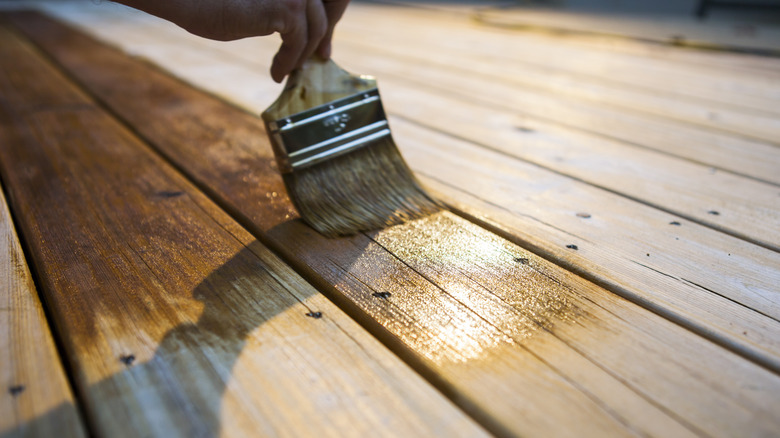The Step You Might Be Missing When Staining Your Wood
If you've got some light or untreated wood, such as lumber ready for a beginner-friendly woodworking project, a cherished piece of furniture, or one that needs restoration, it could be time to look into just the right stain. Staining, as opposed to painting, means you can match or complement other wood colors in your home while still enjoying its natural grain pattern. However, if you're a staining newbie, don't make the classic mistake of skipping this crucial step: applying a pre-stain wood conditioner. Without it, your efforts could result in a streak-filled, blotchy mess.
Wood conditioner, much like a stain, primer, and paint, comes in two basic varieties: oil-based or water-based. Make sure that you match an oil-based conditioner with an oil-based stain, and only pair water-based conditioners with water-based stains. Oil-based products take longer to dry, smell pungent, require a mask, and have volatile organic compounds (VOCs), which aren't great for the environment. However, they penetrate the wood deeply for the most durable finish, are great for outdoor application, and show off the wood grain. Water-based stains are quick to dry, much more environmentally friendly, and great for a refreshed wood color that lives indoors. On the other hand, they're also less durable and the water can damage your wood due to raised grain.
Best way to use wood conditioner
Once you've decided whether to use an oil- or water-based stain, you can pick up the corresponding pre-stain wood conditioner, which will be completely colorless. As with most projects that involve applying some permanent color, whether stain or paint, your best bet is to prep the wood by first lightly sanding it and cleaning it of any dust particles. It's also a good idea to work outside if you can, especially if you're using an oil-based stain that releases harmful chemicals into the air. Also, for a smooth finish and to avoid bubbles, don't shake your can of wood stain.
With a generously proportioned paintbrush, apply the conditioner evenly to one side of the wood. Let it sit for about 5-10 minutes, and wipe off any excess with a clean rag. Follow the manufacturer's instructions, which will usually advise you to apply the stain within a specific time frame after conditioning it, typically before the two-hour mark. There's a good reason for this. Part of the magic of pre-stain wood conditioner is its ability to prevent streaks and blotches. If it's left on too long, the conditioner acts as a sealant and prevents your stain from adhering. Once everything is dry, turn over your wood to repeat the process on the other side and ends.
